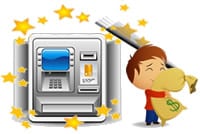Do you have an overdraft line of credit associated with your checking account? We’ll we do. Sometimes it’s a life saver – literally!
This week I paid our mortgage as I always do, but something happened. I must have selected the “other” checking account and I didn’t notice it. Now you know that I check our bank accounts at least weekly, just to keep tabs on what’s going on (w e don’t use a credit monitoring).
e don’t use a credit monitoring).
Well imagine my surprise to see the mortgage payment coming out of that checking. One of the worst things you can do is to bounce your mortgage payment and yikes this could have happened. But thank goodness it didn’t. Our overdraft line of credit saved the day by covering the overdraft. So the mortgage payment is paid and all is well there. I noticed it quickly, so we transferred the funds to pay back the overdraft and all is well.
If you don’t have overdraft protection on your checking account, you may want to think about it. It saved us this time.






 Since the Credit Card Act of 2009, banks have been looking for ways to make up for lost revenue. Has your bank increased fees or even added new fees? Look for changes in…
Since the Credit Card Act of 2009, banks have been looking for ways to make up for lost revenue. Has your bank increased fees or even added new fees? Look for changes in…